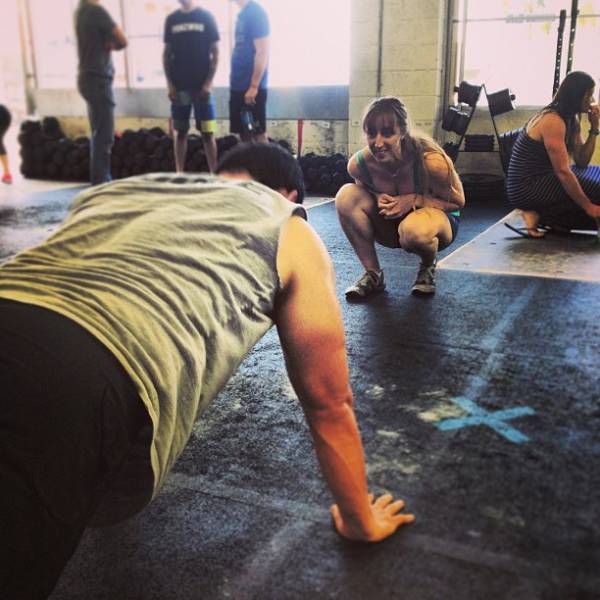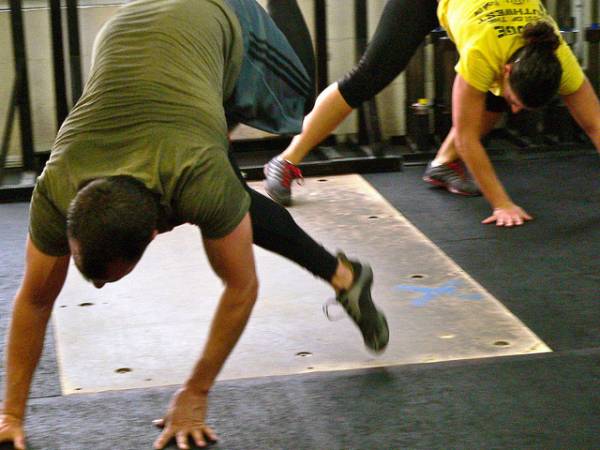Getting stuck in a routine is simple and easy. CrossFit has become a champion of constant variance. This does not mean pure randomness and falling into the constant variation rut, though. CrossFit by definition is “constantly varied function movements performed at a high intensity,” but most participants interpret this as simply showing up to the box, seeing what is on the white board, and saying, “Three, two, one – go!”
You must be aware of your workout programming and the desired effects you are currently trying to achieve. CrossFit should be a balance of consistently working at new movements, weights, intensities, and complexities, as well as incorporating systematic progressive training. You want to avoid pure randomness of workouts, not training for specific goals, and always working out at the same place, same time, and with the same people.
Effective CrossFit coaches recognize the need for a degree of repeatability, consistency, and progressive loading. We have learned that in order to effectively learn a skill, which for this article I am going to argue movements are skills, the level of complexity and depth can vary to a great degree – a bodyweight squat versus the king of complexity, the snatch. To learn skills we must break them down into digestible pieces and perform them repeatedly.
There is a well-known general rule that it takes 10,000 hours to become an expert. This has been applied to careers, and also specifically to athletes. In CrossFit we are not seeking to become experts at a single task, yet arguably we want to be experts at movement in general. This means we strive for the highest level of mastery of a large domain of movements at high and low intensity for short and long durations.
In translation, to become an effective athlete you need years of practice and performance. More specifically, to become proficient at a movement you need repetition. Estimates for how many repetitions required to effectively learn a movement are between 300 to 3,000, and to master the skill is between 30,000 to 50,000 according to some sources. The important issue is not the number of repetitions nor the number of hours it takes to become an expert. This all varies depending on your definition of expert, the quality of the hours, the quality of the reps, and the ability of the individual to learn. What is important is that the ability to perform any single movement with virtuosity takes time and practice. Simply translated, you can’t walk into your box every day, perform the workout, and head home, leaving one-hundred percent of the responsibility to your coaches.
 If you are struggling with a movement, are prone to usual injuries, or want to improve your performance, it’s going to require specific attention to one area of your fitness. The term fitness here is used to describe energy system utilization, skill, mobility, and all the other principles of CrossFit. Take time to self-evaluate and ask for feedback from your coaches. “Where are my weaknesses and what do I need to do to improve them?” For more specific movement instruction, seek advice from a FMS (Functional Movement Screen) professional, a NASM Corrective Exercise Specialist, or perform self-screens to identify your personal areas needing improvement. Once you’ve determined individual weaknesses, either take time away from the gym to address these issues or dedicate extra time before and after your workouts.
If you are struggling with a movement, are prone to usual injuries, or want to improve your performance, it’s going to require specific attention to one area of your fitness. The term fitness here is used to describe energy system utilization, skill, mobility, and all the other principles of CrossFit. Take time to self-evaluate and ask for feedback from your coaches. “Where are my weaknesses and what do I need to do to improve them?” For more specific movement instruction, seek advice from a FMS (Functional Movement Screen) professional, a NASM Corrective Exercise Specialist, or perform self-screens to identify your personal areas needing improvement. Once you’ve determined individual weaknesses, either take time away from the gym to address these issues or dedicate extra time before and after your workouts.
Also as a student, you need to beware of your instructor’s ability to fall into the trap of bias. Instructor bias simply means everyone has a tendency to program workouts that they like and are good at, rather than a balanced, full spectrum of workouts and modalities. This means it’s easy for CrossFit gyms that champion constant variance to get stuck in an unintentional rut. I know this as a CrossFit coach and manager. In order to effectively combat bias and have continual variance, I utilize a team of individuals to assist in programming, versus relying on just myself. In addition, scheduling also needs to be examined, records need to be kept, and purposeful attention must be paid to future evolution. Accurately capture this information by analyzing gym members, observing where average client weaknesses are, noting any injuries, and monitoring performance gains.
Most importantly, you must also seek to be a constant and attentive student to your sport. If education and progressive knowledge aren’t a priority, you are being left behind as each day brings new research studies, theories, and answers. Ultimately you must have a coach who can assist in individualizing your plan, take on that responsibility yourself, or work together on it. That being said, don’t invest your entire future in a single coach or team of coaches. When traveling for work or vacation, visit another gym, attend a training or certification, work out with different partners, explore the outdoors, and seek to learn beyond a single environment.
 Never stop growth and improvement. Surround yourself with great coaches and athletes who support your mission, whether your goal is to become the best possible version of yourself, lose weight, or compete at the CrossFit Games. I encourage you to follow the steps below to aid both you and your coaches in building an individualized comprehensive program.
Never stop growth and improvement. Surround yourself with great coaches and athletes who support your mission, whether your goal is to become the best possible version of yourself, lose weight, or compete at the CrossFit Games. I encourage you to follow the steps below to aid both you and your coaches in building an individualized comprehensive program.
1. Assess where you currently are, using specific metrics. For example:
- Weight
- Body Composition
- 1RM totals for squat, deadlift, weighted pullup, overhead press, clean, jerk, snatch
- Benchmark workout results – Angie, Cindy, Fran, Grace, Jackie, etc.
- 400m time
- 5k time
2. Define your goals for 1 month, 3 months, and 6 months.
3. Define your training schedule:
- Days per week
- Number of box WODs
- Workouts outside CrossFit box
- Prehabilitation and mobility needs
4. Share this information with your coaches and work together on a plan!
Photos provided by CrossFit LA.






